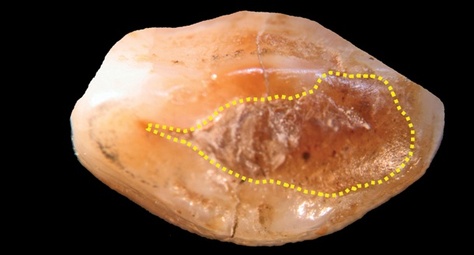 This is a picture of a human lower jaw (mandible), that is 6,500 years old. It shows that a crack in an upper eyetooth (canine) was sealed with beeswax. This is shown surrounded by the dotted yellow line).
This is a picture of a human lower jaw (mandible), that is 6,500 years old. It shows that a crack in an upper eyetooth (canine) was sealed with beeswax. This is shown surrounded by the dotted yellow line).Researchers from Australia and Italy appear to have found physical proof that restorative dentistry dates to the Stone Age. The researchers identified traces of a dental filling made of beeswax in a Neolithic human tooth discovered in Slovenia, and they are saying it may be the “earliest known direct evidence of [a] therapeutic-palliative dental filling.”
Stone Age caveman dentistry has been discovered by Australian and Italian researchers. They found evidence of this tooth filling that consisted of beeswax. This dentistry was first performed in the tooth of a Neolithic human who lived in, or was visiting relatives in Slovenia. It is believed that this may first known evidence of a restorative (palliative- treatment of pain) dental restoration.
Danbury, Ct Jay M. Marks, DMD explains that the examination shows that the tooth was worn down the tooth and probably had the dentin exposed. No doubt the tooth was very sensitive to chewing and drinking. The beeswax would have protected the nerves in the dentin from hot and cold, and other insults.
It is not known if the stone age dentist kept dental records, but if he did, it would have revealed that the patient was a male in his 20's. The specimen was of the left side of the lower jaw with 2 molars, 2 bicuspids and an eyetooth. The dental office was located in a cave in Slovenia near the Loche, Istria village.
Beeswax has been documented to be used as a binding agent in prehistoric times which explains its ability to function a long time due to its stability. So, if you would like to know if you need any present day tooth restorations (beeswax available only upon special request), or would like a complimentary consultation about any dental condition, please contact us today.
It is not known if the stone age dentist kept dental records, but if he did, it would have revealed that the patient was a male in his 20's. The specimen was of the left side of the lower jaw with 2 molars, 2 bicuspids and an eyetooth. The dental office was located in a cave in Slovenia near the Loche, Istria village.
Beeswax has been documented to be used as a binding agent in prehistoric times which explains its ability to function a long time due to its stability. So, if you would like to know if you need any present day tooth restorations (beeswax available only upon special request), or would like a complimentary consultation about any dental condition, please contact us today.

